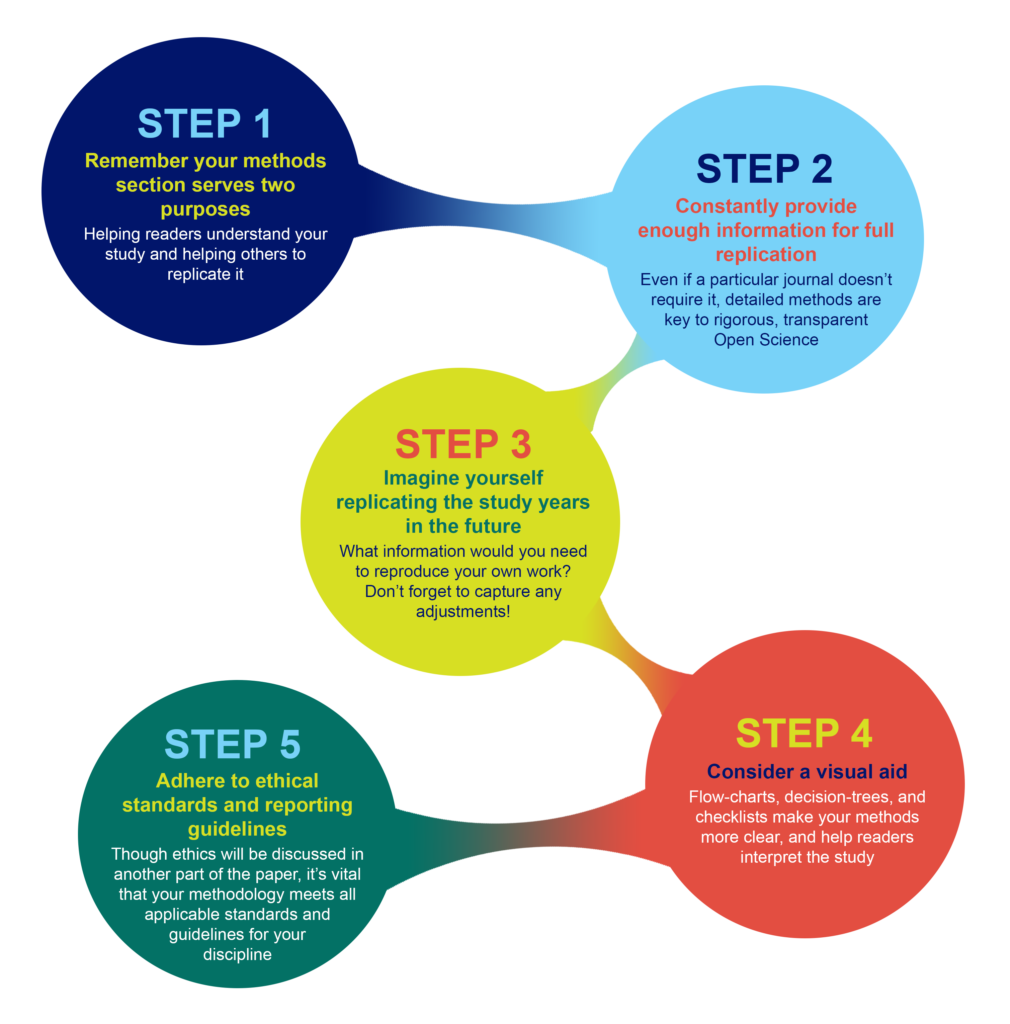The methods section tries to describe all the constituents of the research design as a whole. It captures those techniques or procedures which the researcher has deployed to answer the research questions and resolve the hypothesis. The section explains the procedures used to collect data as well as the techniques for data analysis, among others. In other words, the methods section explains the ways which researchers used to identify, collect, process, and analyze data/information for their papers. A cogent explanation of these procedures and techniques is very necessary because it allows readers to critically examine the overall validity and reliability of the empirical findings of the paper.
The following tips should help shed more light on how to write the methods section of a research paper

Write according to your field of study
Research methods vary according to field or discipline of study. For example, methods in the natural sciences are largely experimental unlike the social sciences where a variety of other scientific methods are used. Therefore, researchers need to contextualize their research methods within the norms of their respective faculty and/or department of study. You must also select a research design and organize your methods according to the framework of that design.
If you decide to use methods that are not within the scope of your discipline, be sure to explain such methods thoroughly and also offer your reasons for using them in addition to narrating how they help solve the research problem.
Explain your methodological and data collection approaches in detail
There are several kinds of research that can be classified in a number of ways. Thus, you have to clearly explain the approach or approaches you adopted for your paper. For example, is your research quantitative, qualitative, or mixed? Did you use primary or secondary data? Did you collect data via observation, interviews, surveys, questionnaires? Was the data collected personally by you or posted/mailed? Did you work with research assistants? What problems did you face during the data collection process? All the procedures you passed through to ensure that you collected valid data should be stated. If you used secondary data, specify the nature of the data and the sources you collected the data from.
Ensure that your approaches are suitable for the research problem
A serious setback in many research papers is the inappropriateness of the adopted research methods to help meet the study’s objectives. To avoid this, try and ensure that your data collection and analysis methods and your research design as a whole revolve around the research problem.
For those working with primary data, one way of achieving this, especially when writing a dissertation, is through the use of pilot studies. If you are using secondary data for regression analysis, you can try several iterations using regression software until you arrive at suitable research methods. Note that you need to specify at least one model when using regression analysis.
Elaborate on your data collection techniques
After the sometimes herculean task of collecting data, you must then comprehensively describe the techniques through which you intend to measure and subsequently analyze the data. For example, if it is quantitative analysis in the social sciences, you’ll likely opt for statistical, regression, econometric analysis, etc, through the use of computer software such as SPSS, Eviews, and others.
If it is qualitative analysis, try to provide an even more elaborate explanation of the techniques used. Be sure to also include any qualitative software that you used. For example, tools like Computer-assisted qualitative data analysis software (CAQDAS) can help various forms of qualitative research analysis such as grounded theory methodology, transcription analysis, coding and text interpretation, discourse analysis, and recursive abstraction, among others.
Rationalize your sample size/techniques
If you are collecting primary data through fieldwork, then the sampling procedure is a very important. First, you have to briefly discuss the target population that you have identified for your study. After this, you then talk about the sampling technique you wish to draw your subjects from. You may also have to indicate the size of the sample and why you decided to settle for that size. Note that the larger the sample size the better your chances of correctly predicting the characteristics of your target population. Hence, it is more ideal to select a large sample so as to ensure that it is representative enough of the entire population.
Explain the steps you took to ensure validity and reliability
Validity and reliability are very important concepts in research that any researcher must not take for granted. It, therefore, follows that you must elucidate on the measures you took to ensure that your methods are valid and reliable. Validity and reliability procedures vary with the type of research used. For instance, if you conducted experiments, then you’ll be more concerned about internal and external validity while you will be concerned with things like face and construct validity, among others, if you administered questionnaires on your subjects.
Most important takeaway
Because research methods vary according to field of study, you need to have a very clear understanding of the modus operandi in your faculty or department of study. This knowledge and the other tips discussed above will help you determine the most effective way to write the methods section of your research paper.


